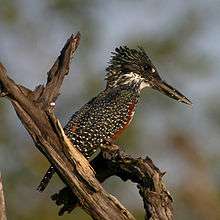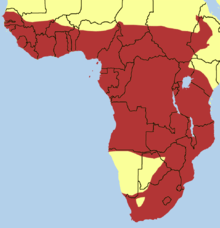Giant kingfisher
| Giant kingfisher | |
|---|---|
_male.jpg) | |
| Male, Lake Naivasha, Kenya | |
 | |
| Female near Triangle, Zimbabwe | |
| Scientific classification | |
| Kingdom: | Animalia |
| Phylum: | Chordata |
| Subphylum: | Vertebrata |
| Class: | Aves |
| Order: | Coraciiformes |
| Family: | Alcedinidae |
| Subfamily: | Cerylinae |
| Genus: | Megaceryle |
| Species: | M. maxima |
| Binomial name | |
| Megaceryle maxima (Pallas, 1769) | |
 | |
| distribution | |
The giant kingfisher (Megaceryle maxima) is the largest kingfisher in Africa, where it is a resident breeding bird over most of the continent south of the Sahara Desert other than the arid southwest.
Subspecies
There are two subspecies, M. m. maxima, found in open country, and M. m. gigantea in the rainforest. The forest race is darker, less spotted above, and more barred below than maxima, but the two forms intergrade along the forest edge zone.
Reproduction
Breeding is from August to January, 3–5 eggs being laid in a riverbank tunnel.
Description
The giant kingfisher is 42–48 cm (16½-18⅞ inches) long, with a large crest and finely spotted white on black upperparts. The male has a chestnut breast band and otherwise white underparts with dark flank barring, and the female has a white-spotted black breast band and chestnut belly.
Call
The call is a loud wak wak wak.
Diet
This large species feeds on crabs, fish, and frogs, caught in the typical kingfisher way by a dive from a perch.
References
- ↑ BirdLife International (2012). "Megaceryle maxima". IUCN Red List of Threatened Species. Version 2013.2. International Union for Conservation of Nature. Retrieved 26 November 2013.
| Wikimedia Commons has media related to Giant Kingfisher. |
- C H Fry & Kathie Fry (2000). Kingfishers, Bee-eaters and Rollers. Illustrated by Alan Harris. Princeton University Press. ISBN 0-691-04879-7.
External links
- Giant kingfisher - Species text in The Atlas of Southern African Birds.

_female_composite.jpg)